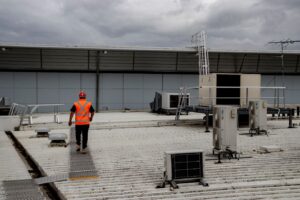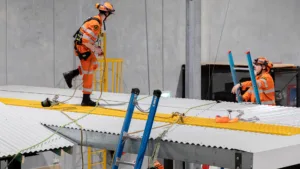Decisions are rarely made in a vacuum. And that is even more apparent when you consider what goes into making choices about height safety and fall protection.
The rate of accidents occurring because of falls from height has not moved a great deal any time over the last 25 years. In fact, by several metrics, things are getting worse.
Data from Safe Work Australia shows that the median amount of lost time following a fall has increased from a median of under six weeks, per accident, in 2008-9 to more than eight weeks in 2020-21.
The rate of fatalities occurring from falls has also remained firmly at approximately 10 per cent of workplace deaths. In raw numbers, the needle barely shifted in the decade from 2011 to 2021 and has decreased only slightly in the handful of years since.
Over the same timeframe, Australia has seen the unification and strengthening of work health and safety legislation, and the requirement for (and delivery of) nationally accredited safety training has increased. Inspection and enforcement from regulatory bodies has also ramped up.
By all measures, the number and severity of injuries resulting from falls at workplace should be decreasing. But they are not.
The question becomes, why?
Most dangerous phrases and their origins
“Oh, it won’t happen to me.”
“I’ll be fine.”
“I’ve done this plenty of times before.”
It is almost certain that these phrases, and others like them, are uttered across an untold number of workplaces every day. And, really, in many cases, they are right. It will not happen to them. They will be fine.
Although it does not have a lot to do with them having done it plenty of times before.
This sort of thinking is a particular type of cognitive bias. When presented with a situation where an adverse outcome is possible, but unlikely, there is a belief that the unlikely outcome is impossible. Which is not the case.
You can see how that comes about when you put some statistics about high-risk work, accidents and fatalities into context.
National Centre for Vocational Education Research data shows that between 2018 and 2022, over 650,000 people in Australia completed nationally accredited work safely at heights training (either RIIWHS204D Work safely at heights or RIIWHS204E Work safely at heights).
In that same that same time frame there were 101 workplace fatalities recorded by Safe Work Australia that were attributed to falls.
This demonstrates that amongst all the people that completed height safety training across those five years, a small fraction of a percent of them (0.01%) were involved in a fatal workplace fall.
Of course, that is not the whole story. The training numbers do not consider anyone that completed training prior to 2018, and those that have never completed formal, accredited training, but still work at height on a regular basis.
As the denominator of the equation grows from the addition of all these, it follows that in any one individual instance the risk of a person suffering a fatal fall from height is incredibly low.
“It won’t happen to me.”
But it does.
Adding fuel to the fire
It is not just the mathematic probability that fuels a worker’s sense that the likelihood of an accident happening to them are so incredibly low as to be essentially zero.
Research conducted by SafeWork NSW (the state’s workplace health and safety regulator) with workers and supervisors in the construction industry revealed how the attitudes and thinking they have towards work at height feeds into the bigger height safety picture.
The most unsurprising revelation is that workers have substantially differing views on what constitutes “work at height”. In the Work Health and Safety Regulation 2017 (NSW), it describes a fall from height as any fall “from one level to another” that is “reasonably likely” to hurt the worker or another person.
For workers in the construction industry, they take “heights” to mean anything above two storeys (six metres or more, in a typical suburban house). This is the widely accepted height at which most people surveyed agree that a fall is reasonably likely to cause injury.
However, the most serious and fatal flaws reported to SafeWork NSW occur at heights of four metres or less.
Following on from that is the finding that “most workers are confident they can determine what is safe vs unsafe”. That said, there is very little consistency between workers as to what constitutes safe.
Upon viewing photos by SafeWork inspectors of what workers considered to be “safe” environments, they found that many would, in fact, be unsafe.
But even with this, there is acknowledgement amongst workers that they will knowingly step into an unsafe environment to perform a quick fix if it means getting the job done.
Structures, but not as you know it
The influence of the structures in which a worker operates is the biggest single cause of workplace accidents.
In this context, structures do not mean the physical buildings or workplaces. These structures are of a different variety – the businesses people work for, the general expectations and behaviours exhibited at work. It is the people and their relationships with each other, and the work being performed. The relationship between a worker and their employer, the employer and the job site.
These types of personal/social structures influence the choices a person makes in a moment. It being acceptable practice to “just get the job done” no matter what the risks comes from here.
Safety shortcuts being taken because there has been insufficient time allowed in the planning of the job to implement the required safety measures is an influence of these structures.
Put another way, these structures tend to be a critical reason for the decision to deprioritise safety to support other aspects of work (for example, getting the job done, minimising cost, maximising profit).
It does not have a to be a negative though. Social structures like this also create opportunity for achieving better outcomes.
Going back to the SafeWork NSW research, it found that workers are heavily influenced by friends, family and work supervisors, and are responsive to safety messages that highlight that highlight the impact a workplace accident can have.
Moving the needle
Getting substantial movement in the rate of workplace accidents and fatalities resulting from falls is going to take significant amounts of work and different ways of thinking.
One of the clearer ways change can be created is for employers and site supervisors to ensure that adequate time is allocated for the preparation and execution of workplace safety systems.
For employers, this is simply about making sure that the timeframe quoted for completing a job account for this. Building owners and supervisors need to understand what is required to safely work in their environment and only engage companies that will do this.
The removal of pressure from workers to take unnecessary risks to complete a job is the single biggest influence that can reduce the number of falls at workplaces.
Paired with this is increased understanding for workers that the low probability of an accident is not the same as their being no chance of an accident occurring. Even falls from a minimal distance can have life-changing consequences for workers. And accidents occur in the blink of an eye.
Moving the needle on falls at workplaces requires a holistic approach, and acknowledging all the factors that go into making the decision that leads to the accident.





